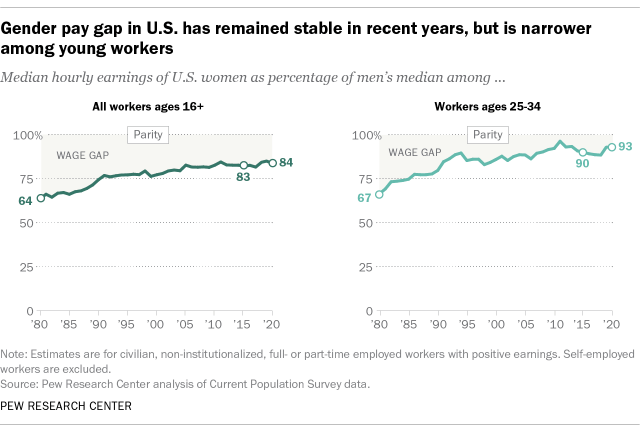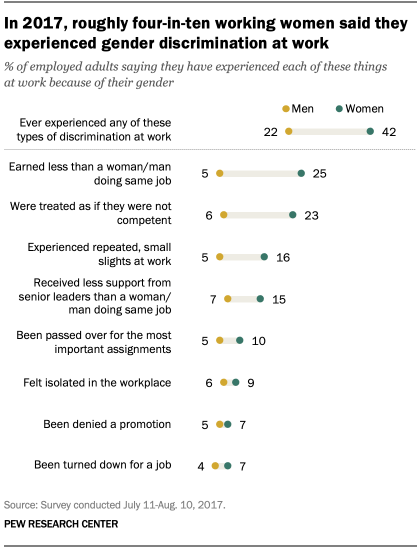How Much Money Do Women On Average Make To The White Man's Dollar
The gender gap in pay has remained relatively stable in the U.s.a. over the past fifteen years or so. In 2020, women earned 84% of what men earned, according to a Pew Enquiry Heart assay of median hourly earnings of both full- and part-time workers. Based on this estimate, it would take an extra 42 days of work for women to earn what men did in 2020.
As has been the case in recent decades, the 2020 wage gap was smaller for workers ages 25 to 34 than for all workers 16 and older. Women ages 25 to 34 earned 93 cents for every dollar a human being in the same age grouping earned on average. In 1980, women ages 25 to 34 earned 33 cents less than their male counterparts, compared with 7 cents in 2020. The estimated sixteen-cent gender pay gap among all workers in 2020 was downwardly from 36 cents in 1980.

The gender pay gap measures the divergence in median hourly earnings between men and women who work full- or role-fourth dimension in the U.S. Historically, men have earned more on boilerplate than women, but the gap has slowly closed over time. The most recent data is from 2020 Current Population Survey Merged Outgoing Rotation Group (MORG) files. To empathise how we summate the gender pay gap, encounter our 2013 post, "How Pew Research Center measured the gender pay gap."
The U.Due south. Census Bureau has also analyzed the gender pay gap, though its analysis looks just at full-fourth dimension workers (as opposed to full- and office-time workers). In 2019, full-time, year-round working women earned 82% of what their male counterparts earned, according to the Census Bureau's well-nigh recent analysis.
Why does a gender pay gap nevertheless persist?
Much of this gap has been explained past measurable factors such equally educational attainment, occupational segregation and work feel. The narrowing of the gap is attributable in large role to gains women accept made in each of these dimensions.
Even though women have increased their presence in college-paying jobs traditionally dominated by men, such every bit professional and managerial positions, women as a whole go along to be overrepresented in lower-paying occupations relative to their share of the workforce. This may contribute to gender differences in pay.

Other factors that are difficult to measure, including gender discrimination, may besides contribute to the ongoing wage discrepancy. In a 2017 Pew Inquiry Center survey, about four-in-x working women (42%) said they had experienced gender bigotry at work, compared with nearly two-in-10 men (22%). I of the nigh commonly reported forms of bigotry focused on earnings inequality. I-in-four employed women said they had earned less than a human who was doing the same job; but 5% of men said they had earned less than a woman doing the same job.
Motherhood can also pb to interruptions in women's career paths and have an bear upon on long-term earnings. Our 2016 survey of workers who had taken parental, family unit or medical exit in the 2 years prior to the survey institute that mothers typically take more time off than fathers after nativity or adoption. The median length of get out among mothers later the nascency or adoption of their child was 11 weeks, compared with one week for fathers. About half (47%) of mothers who took fourth dimension off from work in the two years subsequently nativity or adoption took off 12 weeks or more.
Mothers were besides nearly twice every bit likely as fathers to say taking time off had a negative impact on their job or career. Among those who took leave from piece of work in the two years following the nascence or adoption of their child, 25% of women said this had a negative impact at work, compared with thirteen% of men.

Once women go mothers, juggling family caregiving responsibilities and piece of work tin be a claiming. Mothers, even those who are married and work full time, tend to carry a larger load at home than fathers when it comes to these tasks. In a 2019 survey, mothers with children younger than eighteen were more probable than fathers to say they needed to reduce their work hours, felt like they couldn't give full effort at piece of work and turned downward a promotion because they were balancing piece of work and parenting responsibilities. Roughly one-in-5 mothers said they had been passed over for an important assignment or a promotion at work, while 27% said they had been treated every bit if they weren't committed to their work.
Overall, Americans see equal pay as central to gender equality. In a 2020 survey, 45% of those who said it's important for women to have equal rights with men volunteered equal pay as a specific example of what a society with gender equality might expect like. This response trumped other items such as women non being discriminated against for their gender or women being as represented in leadership positions.
Note: This is an update of a post originally published on March 22, 2019. Former Pew Research Middle staff Nikki Graf and Eileen Patten contributed to this analysis.

Amanda Barroso is a former writer/editor focusing on social trends at Pew Research Center.

Anna Brown is a research associate focusing on social and demographic trends research at Pew Enquiry Center.
Source: https://www.pewresearch.org/fact-tank/2021/05/25/gender-pay-gap-facts/
Posted by: coreyittly1942.blogspot.com

0 Response to "How Much Money Do Women On Average Make To The White Man's Dollar"
Post a Comment